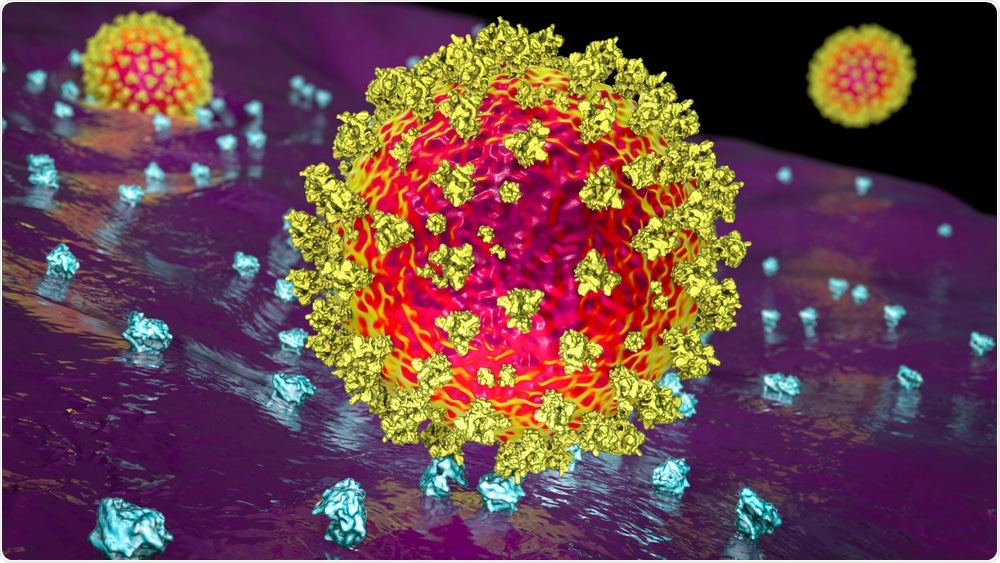The coronavirus disease 2019 (COVID-19), which is caused by severe acute respiratory syndrome coronavirus 2 (SARS-CoV-2), has resulted in more than 5.28 million deaths worldwide. Since the beginning of the pandemic, almost all aspects of SARS-CoV-2 have been studied. However, it remains unclear how the virus acquired the ability to bind and infect human cells.
In a new study published in Evolution, Medicine, and Public Health, scientists attempt to understand the evolution of the receptor-binding domain (RBD) of the spike protein of SARS-CoV-2. Herein, they discuss the ability of RBD to bind to the angiotensin-converting enzyme 2 receptor (ACE2) receptor of humans evolved in coronaviruses. The researchers of the current study also apply an alignment-free technique to understand functional relatedness among betacoronaviruses.
 Study: A novel predictor of ACE2-binding ability among betacoronaviruses. Image Credit: Kateryna Kon / Shutterstock.com
Study: A novel predictor of ACE2-binding ability among betacoronaviruses. Image Credit: Kateryna Kon / Shutterstock.com
About the study
In the current study, the researchers utilized the physicochemical properties of amino acids to develop fully dynamic waveform representations of proteins. These proteins are responsible for encoding both the amino acid content and the context of amino acids.
The waveforms were then subjected to dynamic time warping (DTW) and distance evaluation. This was done to develop a distance metric, which would be less sensitive to variation in sequence length and primary amino acid composition.
The waveforms were used to determine the propensity of betacoronaviruses to infect human beings. The usefulness of this new approach in the biosurveillance of coronaviruses was established by comparing it with existing phylogenetic methods.
Study findings
Scientists have been trying to develop methods that could cost-effectively and rapidly predict the capability of any newly discovered coronavirus to make the zoonotic leap to humans. The ability to bind to the ACE2 receptor is key to this transition.
Four of the pangolin coronavirus RBDs used in the current study were not investigated with respect to ACE2 binding. GXP2V and MP789 are two pangolin coronaviruses that have been previously investigated and confirmed to bind ACE2. These coronaviruses were found in the unified cluster defined by the authors, which suggests that the ACE2-binding ability of some or all other coronaviruses will ultimately be confirmed.
Scientists concluded that GXP1E may not bind to ACE2. The non-DTW method predicted this without any manual examination of the RBD. This is significant, given the high degree of similarity between GXP1E and GXP2V, a confirmed ACE2-binding betacoronavirus RBD.
This observation, therefore, demonstrates the power of non-DTW waveform-based methods to discriminate between ACE2-binding and non-ACE2-binding RBDs. However, the researchers warn that the method should be applied cautiously, as a deletion could have a magnified effect on the distance comparisons and may, in some cases, shift the placement of a single taxon artificially.
Aside from the ability to identify newly sequenced ACE2-binding RBDs, the waveform-based methods provide insights into the evolutionary process of RBDs. The current SARS-CoV-2 RBD, wherever it came from previously, has evolved to the point of ACE2-binding and the newly developed methods shed light on this evolution.
The topology based on the waveform analysis was found to be superior to the alignment-based maximum likelihood (ML) topology. Regarding evolution, scientists cautioned that convergence and recombination could happen simultaneously and, therefore, mutual exclusivity should not be assumed.
In fact, it may be premature to exclude convergent evolution as the primary mode of evolution, given that researchers were able to consolidate the groups of ACE2 binding RBDs using physicochemically-derived waveforms.
The three-dimensional structure of proteins and their function is very tolerant of changes in their primary sequence. The method used in this study exploited that principle in an objective manner and, independent of structural modeling, thereby allowing for the evaluation of physicochemical clustering.
The current method, being based on the context and content of amino acids, preserves the evolutionary assumption and does not generate a spurious metric based on shared characteristics. The researchers state that the complimentary use of standard alignment-based and waveform-based methodologies is desirable because, in the absence of the waveform equivalent of multiple sequence alignment, bootstrapping to provide indications of branch support will not be possible.
The development of waveform-guided amino acid alignment, similar to current amino acid-guided nucleotide alignment, might be a fruitful avenue for future research and a valuable extension of the current method.
Conclusion
One of the most important questions facing scientists is whether a newly emerged betacoronavirus has the ability to bind to ACE2. The waveform-based approach used in this study resulted in a single cluster of ACE2-binding coronavirus RBDs and has proved to be extremely useful in detecting potential betacoronavirus zoonoses before they become active in the human population.
The researchers have advocated for increased surveillance in both animal and human populations to identify coronaviruses with the potential to experience zoonoses. This would lead to a wider-scale screening and sequencing that would help in the characterization of new variants as they emerge.